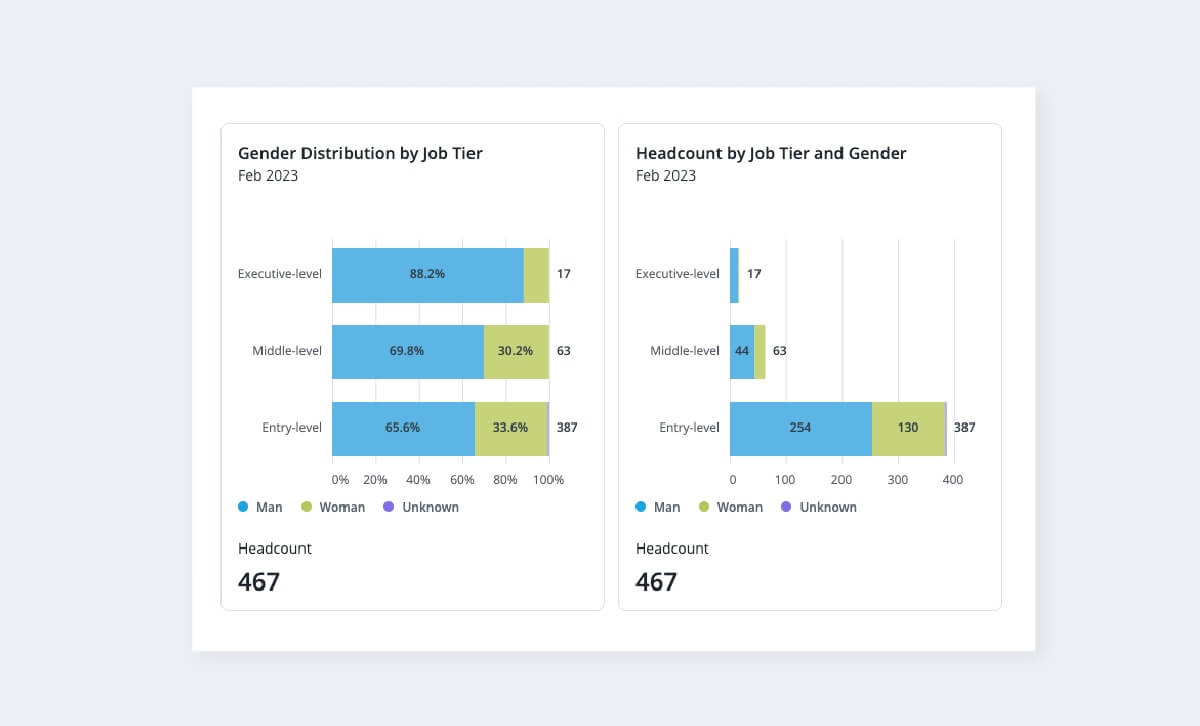3 Steps to Comply With CSRD ESRS S1 Reporting Requirements
The ESRS S1 Own Workforce section of the EU CSRD outlines 30+ people metrics that require mandatory structured reporting. Learn how HR leaders can use people analytics to prepare.

The EU is in the process of implementing some of the most stringent corporate reporting requirements. The ESRS S1 Own Workforce section of the Corporate Sustainability Reporting Directive (CSRD) requires 30+ people metrics that span the CHRO’s remit. Soon, every company with more than 250 employees must report on a range of people measures including pay ratios, pay gaps, diversity performance, complaints and disputes, work-life balance indicators, training provision, and many more.
For people analytics and HR leaders trying to prepare for the new CSRD reporting requirements in the best way, here are three pointers to help you build and finesse your reporting strategy.
1. Map stakeholders
Are your HR and ESG reporting teams aligned with the right stakeholders in your business to deliver the ESRS S1 Own Workforce measures?
As a people analytics leader or CHRO, you want to own and shape this project, perhaps in conjunction with a dedicated sustainability or ESG team. To do this, you’ll need to get all the relevant stakeholders on board. Wider HR and PA teams are a given, as are board members who will want to know more when they realize detailed workforce information is about to become available to investors, activists, campaigners, prospective hires, to the media—to anyone who wants to look at it.
There are second and third circles of stakeholders, too. These may include corporate reporting teams, legal, media relations, brand, investor relations, ESG/sustainability, corporate governance, finance and the CFO, employee representative groups, and IT. There will certainly be more groups, and different combinations for different businesses and sectors. You’ll need to tailor presentations for each audience to make sure you stay in the driver’s seat.
2. Adopt a single source of truth
How will you review the Own Workforce requirements? Do you have access to the data and systems needed? Can you analyze and distribute the right workforce data easily and securely?
There’s a large operational aspect to CSRD readiness. You may need to set up a separate team or group focused on how a your organization will successfully comply with CSRD requirements as described in the ESRS S1 Own Workforce measures. You need to know how you’ll produce and submit 30+ meaningful people metrics to comply with the new rules.
First of all, you will have to review the new requirements to understand the scope and project ask. And if you want to own the project, you’re going to have to understand the organizational challenges more than those working in other functions. When a difficult question arises you are the one who the stakeholders should most often look to.
If you've been trying to get a budget or funding to upgrade people analytics and workforce management technology or platforms, your hand just got stronger. Fines for noncompliance are real, as is the public image fallout. An inability to properly comply is likely to raise questions from your own workforce over time, especially if the organization has been following a narrative about caring for people. If that’s true, why hasn’t the company been measuring these elements already, or doing it so poorly?
EU CSRD requires mandatory structured reporting for 47 different people metrics and written commentary explaining key changes year over year. This task is too large to spend time fiddling with homespun Excel spreadsheets, trying to cobble something together. A people analytics solution like Visier comes pre-loaded with the functionality you need to do this properly.

3. Share insights and drive change
Can you formulate an effective CSRD reporting plan that brings in the right workforce commentary? Do you understand how this will impact your business beyond fines? What does this mean for your employee brand and employee experience proposition?
The CSRD requirements also include meaningful commentary to accompany the metrics. Assign a workback team to come up with and test the stories and commentary on each one. This is a task that will be suited to a particular skill set, so reach out beyond your team to help. It’s also a great opportunity to work with other functions and the C-suite, as the commentary made should align with—and possibly even shape—overall corporate strategy.
People analytics are critical to prepare reports that comply with EU CSRD ESRS S1 Own Workforce requirements. When leaders have access to data to make faster and better decisions about productivity, L&D and training needs, workforce planning, and talent requirement, they can report with confidence and make a strategic impact on the business.
This article is part of a series on CSRD advice for CHROs. Find out more about CSRD here.
On the Outsmart blog, we write about workforce-related topics like what makes a good manager, how to reduce employee turnover, and reskilling employees. We also report on trending topics like ESG and EU CSRD requirements and preparing for a recession, and advise on HR best practices like how to create a strategic compensation strategy, metrics every CHRO should track, and connecting people data to business data. But if you really want to know the bread and butter of Visier, read our post about the benefits of people analytics.



